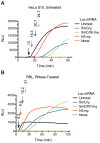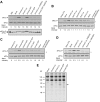N1-methyl-pseudouridine in mRNA enhances translation through eIF2α-dependent and independent mechanisms by increasing ribosome density
- PMID: 28334758
- PMCID: PMC5449617
- DOI: 10.1093/nar/gkx135
N1-methyl-pseudouridine in mRNA enhances translation through eIF2α-dependent and independent mechanisms by increasing ribosome density
Abstract
Certain chemical modifications confer increased stability and low immunogenicity to in vitro transcribed mRNAs, thereby facilitating expression of therapeutically important proteins. Here, we demonstrate that N1-methyl-pseudouridine (N1mΨ) outperforms several other nucleoside modifications and their combinations in terms of translation capacity. Through extensive analysis of various modified transcripts in cell-free translation systems, we deconvolute the different components of the effect on protein expression independent of mRNA stability mechanisms. We show that in addition to turning off the immune/eIF2α phosphorylation-dependent inhibition of translation, the incorporated N1mΨ nucleotides dramatically alter the dynamics of the translation process by increasing ribosome pausing and density on the mRNA. Our results indicate that the increased ribosome loading of modified mRNAs renders them more permissive for initiation by favoring either ribosome recycling on the same mRNA or de novo ribosome recruitment.
© The Author(s) 2017. Published by Oxford University Press on behalf of Nucleic Acids Research.
Figures







Similar articles
-
Membrane-dependent relief of translation elongation arrest on pseudouridine- and N1-methyl-pseudouridine-modified mRNAs.Nucleic Acids Res. 2022 Jul 22;50(13):7202-7215. doi: 10.1093/nar/gkab1241. Nucleic Acids Res. 2022. PMID: 34933339 Free PMC article.
-
Incorporation of pseudouridine into mRNA enhances translation by diminishing PKR activation.Nucleic Acids Res. 2010 Sep;38(17):5884-92. doi: 10.1093/nar/gkq347. Epub 2010 May 10. Nucleic Acids Res. 2010. PMID: 20457754 Free PMC article.
-
N(1)-methylpseudouridine-incorporated mRNA outperforms pseudouridine-incorporated mRNA by providing enhanced protein expression and reduced immunogenicity in mammalian cell lines and mice.J Control Release. 2015 Nov 10;217:337-44. doi: 10.1016/j.jconrel.2015.08.051. Epub 2015 Sep 3. J Control Release. 2015. PMID: 26342664
-
Effects of mRNA Modifications on Translation: An Overview.Methods Mol Biol. 2021;2298:327-356. doi: 10.1007/978-1-0716-1374-0_20. Methods Mol Biol. 2021. PMID: 34085254 Review.
-
Why U matters: detection and functions of pseudouridine modifications in mRNAs.Trends Biochem Sci. 2024 Jan;49(1):12-27. doi: 10.1016/j.tibs.2023.10.008. Epub 2023 Dec 14. Trends Biochem Sci. 2024. PMID: 38097411 Free PMC article. Review.
Cited by
-
Nanoformulations targeting immune cells for cancer therapy: mRNA therapeutics.Bioact Mater. 2023 May;23:438-470. doi: 10.1016/j.bioactmat.2022.11.014. Epub 2022 Dec 1. Bioact Mater. 2023. PMID: 36471724 Free PMC article.
-
mRNA-Based Protein Replacement Therapy for the Heart.Mol Ther. 2019 Apr 10;27(4):785-793. doi: 10.1016/j.ymthe.2018.11.018. Epub 2018 Dec 6. Mol Ther. 2019. PMID: 30611663 Free PMC article. Review.
-
Selective Xi reactivation and alternative methods to restore MECP2 function in Rett syndrome.Trends Genet. 2022 Sep;38(9):920-943. doi: 10.1016/j.tig.2022.01.007. Epub 2022 Mar 2. Trends Genet. 2022. PMID: 35248405 Free PMC article. Review.
-
Real-time monitoring strategies for optimization of in vitro transcription and quality control of RNA.Front Mol Biosci. 2023 Sep 11;10:1229246. doi: 10.3389/fmolb.2023.1229246. eCollection 2023. Front Mol Biosci. 2023. PMID: 37771458 Free PMC article. Review.
-
Recent Developments in mRNA-Based Protein Supplementation Therapy to Target Lung Diseases.Mol Ther. 2019 Apr 10;27(4):803-823. doi: 10.1016/j.ymthe.2019.02.019. Epub 2019 Mar 6. Mol Ther. 2019. PMID: 30905577 Free PMC article. Review.
References
-
- Sahin U., Kariko K., Tureci O.. mRNA-based therapeutics–developing a new class of drugs. Nat. Rev. Drug Discov. 2014; 13:759–780. - PubMed
-
- Kormann M.S., Hasenpusch G., Aneja M.K., Nica G., Flemmer A.W., Herber-Jonat S., Huppmann M., Mays L.E., Illenyi M., Schams A. et al. . Expression of therapeutic proteins after delivery of chemically modified mRNA in mice. Nat. Biotechnol. 2011; 29:154–157. - PubMed
-
- Kariko K., Buckstein M., Ni H., Weissman D.. Suppression of Rna recognition by toll-like receptors: the impact of nucleoside modification and the evolutionary origin of RNA. Immunity. 2005; 23:165–175. - PubMed
MeSH terms
Substances
LinkOut - more resources
Full Text Sources
Other Literature Sources

